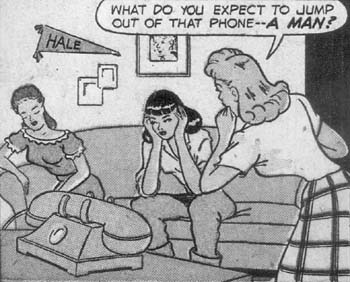![[Metroactive Books]](/books/gifs/books468.gif)
[ Books Index | San Jose | Metroactive Central | Archives ]
What Keeps Comic Books Alive Today?
Two new studies take different approaches to some enduring themes
By Richard von Busack
WHEN TO THE SESSION of sweet, silent, musty old comic books come the approaches of two different critic-historians: Trina Robbins' From Girls to Grrlz: A History of Women's Comics From Teens to Zines (Chronicle Books; 144 pages; $17.95) and Dan Raeburn's The Imp #4 (1454 W. Summerdale #2C, Chicago, IL 60640; 20 pages; $4).
Robbins' survey is a follow-up to her book A Century of Women Cartoonists, reviewed here two years ago. In her new volume, she traces the last 50 years in comics for girls and women. It's an era that began--and in a sense, ends--with the still very popular Archie comics.
Archie debuted in December 1941, begun by the late publisher John Goldwater. Goldwater's obituaries last spring deemed him "the man who created Archie"--thus slighting the Stockton-born artist Bob Montana (1920-75), his hireling, who was actually the man who first inscribed the waffle mark on the side of Archie's head.
As we all know, Archie's eternal teenage life has been complicated by sacred and profane love--torn as he is between Betty, the blonde girl next door, and the more glamorous and wealthy Veronica. These two women were the models for most other female comic-book characters for the next few decades.
Veronica presaged glamour comics like Katy Keene, which offered paper dolls to dress. Robbins claims that the young couturiers Betsey Johnson, Calvin Klein and Anna Sui all got their start dressing these dolls. Betty's lack of pretension anticipated dozens of other gal-next-doors, starring in since-forgotten comic books: Susie, Torchy, Ginger. So lucrative was the girls comic-book market in the years before television that many silver-age superhero-creating artists, such as Jack Kirby, Stan Lee and Wally Wood, were all busily turning out comic books for girls.
In the '50s, what had been wholesome teen adventures grew a little saltier. The sexiness of the comics attracted the attention of Dr. Frederick Wertham, whose bestseller Seduction of the Innocent exposed erstwhile adult items in kids comics. But Wertham's investigations couldn't shut down the advance of grown-up subject matter into comic books.
Some comic-book fans became the underground cartoonists of the '60s. Robbins was one of the best known of these. She credits herself with having drawn "the first comic about a lesbian," the story titled "Sandy Comes Out" for Wimmen's Comics #1 (1973). The anthology Wimmen's Comics, which lasted into the 1980s, led to the comics of present-day female cartoonists, such as Angela Bocage, Roberta Gregory, Jessica "Artbabe" Abel, and the Ariels--Bordeaux and Schrag.
In the many full-color illustrations in Robbins' book, we can see the different styles of the artists, from lush, fussed-over comics of the '50s to the near stickfigure style of today's confessional girl work. Reading Robbins' book is like getting to thumb through what must be one remarkable comic-book collection. (Don't bend the covers back!)
JOHN RAEBURN'S NEW issue of The Imp represents the height of the self-published labor of passion, analyzing not just many unsung geniuses but one well-known misinterpreted one, Chris Ware. Raeburn's chameleonlike annual zine takes the form of whatever he's studying. The Imp #3, for instance, a look at the Christian-comics tycoon Jack Chick, appeared in pamphlet form, just as Chick's delirious books did.
The new issue resembles a five-column tabloid newspaper with the headline "The Smartest Cartoonist on Earth." Raeburn's study comprises dozens of short articles in this "newspaper" on Ware, the Chicago artist of Acme Novelty Library, who is also a regular spot illustrator for The New Yorker.
Without inflating Ware's skills--a temptation, because he's probably the best draftsman in comics today--Raeburn analyzes the importance of nostalgia to Ware's work: how Ware's gorgeously poignant comics draw their strength from ragtime music and the history and the architecture of the city of Chicago.
Also regular sources for Ware are the trumpeting brashness of the 1900 Sears catalog, "The Acme of American Books"--and the evil twin brother of the Sears catalog, the Johnson-Smith novelty catalog, which was selling X-Ray Specks, ventriloquist kits and Sea Monkeys to children as late as the 1960s.
It's easy to say that Ware's comics are primarily nostalgic, but Raeburn goes further and talks about the use of time in Ware's panels--how the dynamics of the comic enable the reader to see the future, the present and the past in the space of one page.
The most kindly judgment is that comics have a better past than a future. Sales keep declining, as does quality, which has made nostalgists out of so many in the comics trade. Robbins' book notes--as anyone who reads self-published girl comics will note--that many of the self-published women's comics today are as focused on gaining too much weight and boyfriends who won't call back as any Archie comic. Robbins writes: "Not much happens, and what does, happens in 'real time.' Girls agonize over boys, attend concerts, sit in cafes, discuss their relationships with their girlfriends. No real conclusions have been drawn by the end of the book."
In their different ways, both of these studies ask: What keeps comics alive? For Robbins, it's the old dream of the underground cartoonists--the chance that the lessons of feminism can be passed around in an easily read and enjoyable form. Ware, quoted by Raeburn, has a different idea: "The only reason why comics have survived ... is because they have some sort of inherent aesthetic power that nothing else does."
[ San Jose | Metroactive Central | Archives ]
Copyright © 1999 Metro Publishing Inc. Metroactive is affiliated with the Boulevards Network.
For more information about the San Jose/Silicon Valley area, visit sanjose.com.
![]()

Think Tank: Trina Robbins' new study of women's comics begins with a serious question.
From the September 2-8, 1999 issue of Metro, Silicon Valley's Weekly Newspaper.